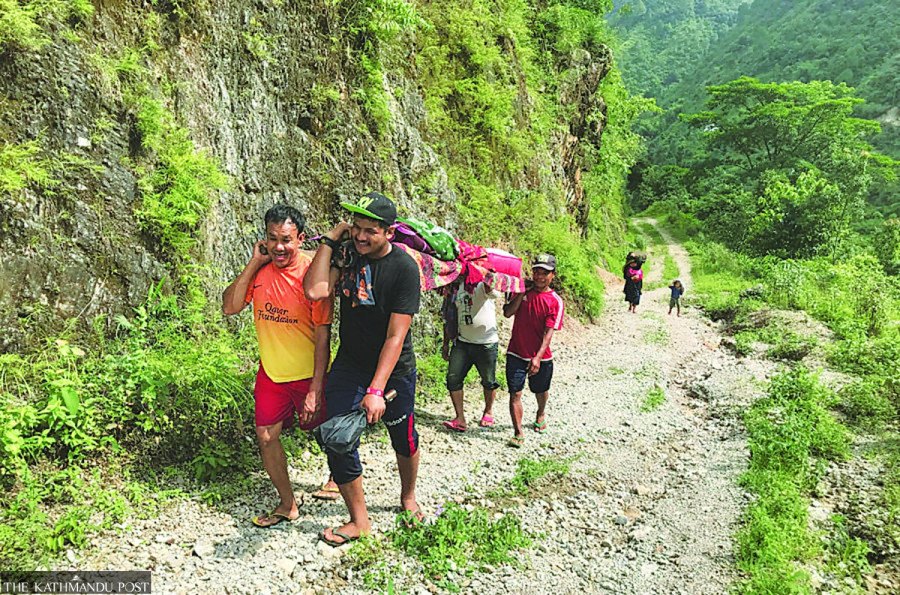Health
Call for better surveillance amid rising maternal deaths
More than 90 maternal deaths have been reported across the country in seven months.
Arjun Poudel
Last week, Sarita Neupane Gajurel, from Bidur Municipality-5 Pipaltar of Nuwakot district, died of birth-related complications.
She had given birth to her baby through the cesarean section at Trishuli Hospital in Nuwakot but after her condition started deteriorating, doctors referred her to Kathmandu.
The 24-year-old new mother was then taken to the Swayambhu-based Manmohan Memorial Hospital, where she succumbed to her infection.
This is not the first time that a new mother has developed fatal complications at the Trishuli Hospital.
At least three maternal deaths have been reported at Trishuli Hospital over the past three years and the family members of the deceased blame the hospital’s negligence for the deaths. Like every time, relatives of the victim obstructed the Pasang Lhamu Highway to protest medical negligence and demanded stern action against the guilty and compensation for the bereaved.
And as usual, the Ministry of Health and Population decided to investigate the death.
“We will carry out a study to find out the cause of death of the new mother,” said Nisha Joshi, an official at the Family Welfare Division under the Department of Health Services. “More can be said on the matter once the report of study comes.”
The Health Ministry said 90 maternal deaths have been reported between July 17 last year and February 12 this year.
In the fiscal year 2021-2022, 180 maternal deaths were recorded throughout the country. The figure was 118 in fiscal year 2020-2021.
Carrying out studies into maternal deaths is a regular duty of the authorities concerned. But it is not known if the government agencies implement the suggestions of any such study.
Officials at the Family Welfare Division said that a ‘verbal autopsy’ on maternal deaths is being carried out in 42 districts and the programme will be expanded in additional 14 districts over the next fiscal year.
Verbal Autopsy, or VA, is a method of determining causes of individuals’ death and cause-specific mortality fractions in populations without a complete vital registration system.
“In the districts where the Verbal Autopsy programme is being carried out, reports are given after the study,” Joshi said. “Responsibilities to enforce suggestions and not to repeat the mistakes lie with the local and provincial authorities of the provinces concerned.”
Maternal death surveillance is a key intervention for improving maternal survival. Such surveillance provides an understanding of the number and causes of deaths.
Excessive bleeding after childbirth and pre-eclampsia and eclampsia (pregnancy-related high blood pressure disorders) have been identified as some of the major causes of maternal deaths in Nepal.
According to the World Health Organisation, systematic analyses of overall mortality trends, as well as events and contributing factors leading to individual deaths, can identify barriers in the health system and inspire local solutions to prevent such deaths in the future.
Health Ministry officials say that they have been investigating the causes of maternal deaths that occur in hospitals under the federal government and in the local and provincial hospitals, if the concerned authorities of such agencies request for the same. Trishuli Hospital comes under jurisdiction of Bagmati Province.
Maternal health experts say that maternal deaths will not decline if health workers do not learn lessons from their earlier mistakes.
“Regular surveillance of maternal deaths are conducted for improvement and not to repeat the mistakes,” said Dr Bishnu Chaulagain, a maternal and child health expert. “Authorities must implement reports of such surveillance to lessen ongoing maternal deaths.”
Nepal had reduced the maternal mortality rate from 539 per 100,000 births in 1996 to 239 per 100,000 births in 2016—for which the country even received the Millennium Development Goals award.
The target under the UN’s Sustainable Development Goals is to reduce maternal mortality rate to 75 for every 100,000 births by 2030.




 8.12°C Kathmandu
8.12°C Kathmandu














